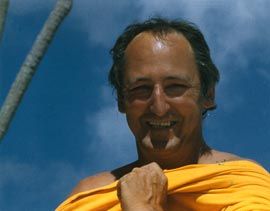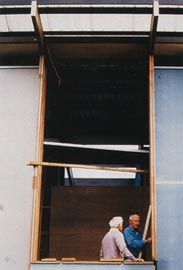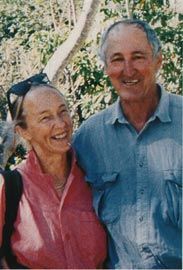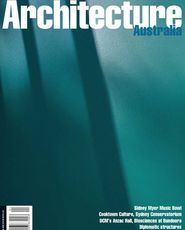
Peter O’Gorman on Fraser Island, 1980.

On site at Wynnum with Graham Mellor, 2000.

With Brit Andresen, Restoration Island, 1999.
Peter O’Gorman, who died on 19 October 2001, made architecture his life’s work. This dedication came not through ambition, or from a search for glory, but through his real generosity of spirit, through love. Love of making, thinking, crafting, understanding. Love of people, love of life. His biography reads simply, and cannot reveal his genius, which expressed itself in his life’s two united works – building and teaching. These twin roles required him to be at once a theoretician, philosopher, teacher, builder, craftsman, designer and architect, never losing sight of humanity and its fundamental joy, nor of the necessity for rigorous quality in everything he produced. Born in Brisbane in 1940, Peter Harry O’Gorman graduated from the University of Queensland in 1964, winning numerous prizes including the A. E. Brooks Travelling Scholarship, and started a sole practice as well as teaching at UQ. In the 1960s, Peter completed what have become known as the “three by one and a half” houses – three small, inexpensive houses using the same builder and the same detailing, constructed from hardwood offcuts, which were then cheap, assembled in repeated clusters and fully demountable. This early approach to system building allowed people with little money access to high-quality architecture, and provided again a practical laboratory for Peter’s deeply rooted but entirely pragmatic theoretical approach. In the late 70s he met Brit Andresen, whom he subsequently married, and they formed a strong architectural partnership. From 1980 they taught, travelled and worked together, and the separation of their two careers since then is difficult. Their first joint work was the expressive and crafted Deer Park Sanctuary Lodge in Buderim, followed by an evolving group of private houses, each being a laboratory, in Philip Goad’s words, “for three things: refining the use of Australian hardwood as a building material; the use of mathematical proportions and harmonic series as ordering devices; and the constant search for an appropriate creation and definition of space”. Over the past 20 years Andresen O’Gorman have completed a score of buildings, most of them tiny. This is a body of work far more significant than it seems – the search for formal and constructional perfection is a slow and laborious one, requiring patience and modesty. The work has been widely published, and was brought to an international audience particularly by the Mooloomba House – lovingly constructed by Peter himself with Graham Mellor, a boat builder friend. Deeply interested in phenomenology, Peter’s fundamental belief was that architecture came from the spirit, one of its geneses being the land, or the specifics of place. His works aimed at sophisticated evolution: growth through Van Eykean concepts of reciprocity. Peter made this an extraordinary art, where a precious and very particular gesture could offer many directions for further development in the broader context. Peter was also fascinated by space and the subtlety of its nuances, exploring particularly the interrelationship of interior and exterior. One of his favourite lecture series was on the Athens Acropolis as a prime example of the eternal truths of spatial orchestration. One can read the presence of the language of the Parthenon so clearly in the Mooloomba house. His reliance on tectonics, on the physicality of making, expressed itself in an almost Ruskinian belief in craft and truth to material, and a wholly personal passion for fine carpentry. While his built work was never ordinary, it celebrated ordinary values of (apparent but hard won) simplicity, of comfort and humanity. The richness of thought and complexity of ordering geometry never raised their voices over the repose and quietness of each space and junction. As well as being an outstanding architect and builder, Peter was one of Australia’s truly great teachers. He was at the heart, with Brit, of an energetic outpouring of creativity in Brisbane from 1977. Work by them and their students – a strong list of names – has the freshness, depth and pervasive quality of a movement or school, united by its approach to climate, its love of timber craft and its modulation of light and space. Former students and colleagues cite his rigorous approach, tempered always by intellect and an impish humour. With Brit and Max Horner, Mick Keniger and Don Watson “Peter shifted architectural education at UQ like an intellectual rocket”. As Edmund Beebe recalls, “he was the only guy who really managed to teach us to conceptualise”. He used theory and critique as a foundation for design teaching, demanding rigour and the abandonment of preconceptions in all aspects of student work. Under his quiet inspiration, the school became a probing, inventive and exciting place of learning. Teachers such as Peter are rare, far too rare in the starved universities of this country, so rare that he will be sorely missed by the profession and his city. Peter never sought to be publicly successful, to be celebrated. His work, and his journey, was far more private, exploring with utmost sophistication his place and time. His offering to the wider world, apart from the endurance of his buildings, will be his teaching. The gathered friends – students, colleagues, family, clients – at his funeral were referred to as Peter’s “tribe”, united forever by his intellect, humour and spirit. His work will live on, as will his inspiration to those he taught. His laconic intellect and twinkling eye will never be forgotten by those who knew him.
Source

Archive
Published online: 1 Jan 2002
Words:
Peter Tonkin,
Ellen Woolley
Issue
Architecture Australia, January 2002














